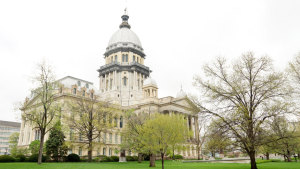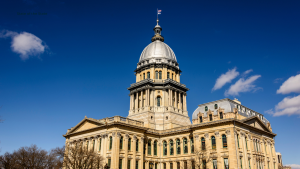Renewable Energy
Renewable energy resources include wind, solar, biodiesel, anaerobic digestion, organic waste biomass, hydropower, landfill gas, and other alternative sources of environmentally preferable energy.

Renewable energy
Illinois is on track to get 25% of its renewables by 2025

energy efficiency
Consumers get the same services for less money

fossil fuels
Burning fossil fuels harms our health and environment

transportation
The transportation sector is now the largest carbon emitter
Embracing the Clean Energy Future
Current Clean Energy Laws
Illinois is at a crossroads. We are transitioning beyond dirty fossil fuels, and a growing clean energy economy could build new economic opportunities across the state, reclaim polluted land, and create thousands of jobs. This new vision for Illinois hit a historic milestone when we passed the Future Energy Jobs Act (FEJA) in 2016. The law becomes effective June 1, 2017.
What is the Future Energy Jobs Act?
The Future Energy Jobs Act (Senate Bill 2814) is one of the most significant pieces of energy legislation ever to pass the Illinois General Assembly. It followed nearly two years of negotiations between energy companies, consumer advocates, and environmental groups.
Renewable Energy Provisions
It fixes funding for Illinois’ renewable energy law, which mandates that 25% of ComEd’s and Ameren’s power come from renewable sources, such as wind and solar, by 2025. For years, the Illinois Power Agency – the state office in charge of managing the utilities’ power purchases – has bought renewable energy with the help of a small charge on the supply side of Ameren and ComEd bills. That’s the portion of the bill that covers the price of the actual electricity you use.
While the Future Energy Jobs Act does not increase funding for renewable energy, it makes a major improvement: It moves that charge to the delivery side of electricity bills. This means that the Power Agency can collect and invest funds much more easily. Also, the Act requires at least 4,300 megawatts of new solar and wind power – enough electricity to power millions of homes – to be built in Illinois by 2030. Never before has Illinois had such a requirement for homegrown renewable energy projects.
Read more about the Future Energy Jobs Act here.
Illinois’ RPS requires specified electric utilities and suppliers to get a certain percentage of electricity from renewable sources. According to this law, renewable sources must make up 25% of overall electric sales by 2025, with wind energy accounting for 75% and solar accounting for 6%. Due to the way municipal aggregation and Illinois’ deregulated energy market interact, the state is currently not on schedule to reach the RPS targets. In fact, renewable energy development in Illinois has essential ground to a halt. A statutory fix is required to simplify the process and get us back on track. A full fix to the RPS wasn’t passed in 2014, but in June 2014, Illinois’ governor signed a bill to allow the Illinois Power Agency to spend $30 million on new, distributed photovoltaic (PV) power. Over the next year new rooftop solar systems will be installed as a result, proving that a fixed RPS could reinvigorate the clean energy economy in Illinois.
A robust self-funded program that provides rebates for residential/commercial and non-profit/government solar and wind energy systems. The (max) $10,000 cash rebate is awarded on a first-come first-serve basis until the program is out of funds for the fiscal year. The program is funded through the Renewable Energy Resources and Coal Technology Development Assistance Charge and does not impact the state budget. The program is mandated by law until 2015.
Since 2008, electric utilities (ComEd, Ameren, MidAmerican) must offer customers credits on their electric bills for electricity generated by renewable energy systems. Eligible renewable generators of 40 kW or less receive a one-to-one retail rate credit. These customers are compensated for excess electricity generated by their renewable energy systems at the same rate that they pay when buying electricity from their utility. Customers with eligible renewable generators between 40 kW and 2 MW receive credits equal to the utility’s avoided cost for their excess generation.
Municipal electric aggregation allows municipalities, counties or townships to purchase electric loads to facilitate the sale to residential or commercial businesses within the municipality or unincorporated areas. Approximately 91 communities in Illinois have achieved “100% renewable energy” with the purchase of renewable energy credits (RECs) through Community Choice Aggregation (CCA).
Renewable Energy Updates
Big Ugly Bill Passes U.S. Congress, Reversing Critical Climate and Environment Protections
State-level action needed to safeguard consumers and Illinois’ climate goals ILLINOIS — Today, U.S. Congressional Republicans passed H.R. 1, informally known as the “Big Beautiful...
Read More >>2025 Legislative Report
IEC's state legislative team has published our 2024 Legislative Report detailing environmental wins and setbacks during this year's legislative session.
Read More >>Shine On: Illinois Hopes to Continue Solar Boom Despite Federal Headwinds
Renewable energy advocates point to a 2021 law and state dollars as reasons for optimism in a challenging time. Illinois Shines, the state’s incentive program...
Read More >>Illinois legislators skip on several environmental bills
Some big environmental bills — dealing with transit, clean energy, plastics and more — fizzled last week in Springfield. Advocates say they’re ready to pick up...
Read More >>Wrapping Up the 2025 Illinois Legislative Session
Our team has been on the ground at the Capitol for the last five months, all the way up until the final moments this evening....
Read More >>Illinois’ Climate Goals and Consumers At Risk Amidst Legislature’s Inaction
Illinois General Assembly misses opportunity to deliver cleaner, lower-cost, more reliable energy amidst rising costs, increasingly extreme weather, and federal mismanagement. ILLINOIS — Today, just...
Read More >>





